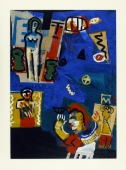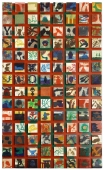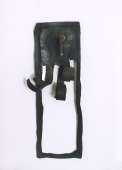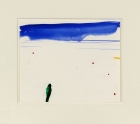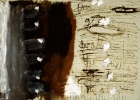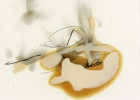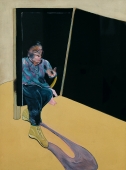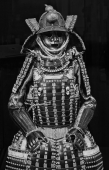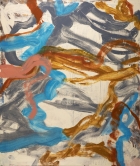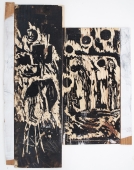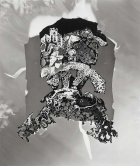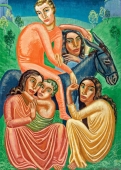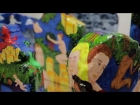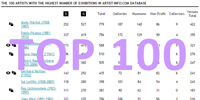Exhibition Catalog Transcript
Bauhaus / 1919-1923 Weimar, 1924 Dessau
Harvard Society for Contemporary Art, Cambridge (MT), December 1930 - January 1931
Read more about the Harvard Society for Contemporary Art on our Blog
https://www.artist-info.com/blog/hsfca
Read more about the first Bauhaus Retrospective in 1930 on our Blog
https://www.artist-info.com/blog/bauhaus100
Introduction
The Staatliches Bauhaus was founded in the City of Weimar in 1919, directly after the war, by the architect Walter Gropius, in collaboration with the Thuringian Republican government, as an experiment in democracy in relation to furthering the applied arts. Gropius at the time was well known in Germany for his pioneering in the new architecture, having before the war built his great Fagus shoe factory, and the glass tower in Cologne. The Bauhaus was to inhabit a building designed by van der Velde, the great Belgian architect and theorist. Van der Velde is a figure of considerable importance. He started the style of the Art Nouveau in Paris in 1901, perhaps the most permanent examples of which are the entrances to the Metro stations. He was called to the Bauhaus in 1914, but the war intervened and he refused to go back afterwards. He has always insisted that the ideas of the Bauhaus were his ideas although his name is rarely mentioned in connection with them. Gropius had ideas of craft work, and an intimate community and socialized guild Spirit. This was related to the return to the medieval sponsored in England by William Morris, and more indirectly by the Viennese organizations such as the WIENER WERKSTETTE.
Johannes Itten, a Swiss pedagogue trained in Vienna, came to the Bauhaus in 1919 to teach the basic principles of post-impressionism and expressionism. It was the first time that these notions had formed the basis of academic instruction. Itten did not want his pupils to go wild in their own personal idioms, but he did want them to develop their creative powers along the lines of the greatest possible original invention and in the real feeling for the material at hand. The students who came to the Bauhaus were as young as fourteen and as old as thirty. They came from all classes, from the rich Berlin profiteering bourgeois, and from the peasantry. Politically speaking they embraced all the febrile beliefs and dogma currently popular. There were anarchists, spartacists, communists, all of them more or less unsettled and rebellious against existing and pre-existing conditions in art and life. There were many foreigners, and the Bauhaus was co-educational from the start. The social experiments ranged from a system of rigid dieting, to an unsanctioned but nevertheless tolerated system of companionate marriage.
A feeling for the occult came to a head as a passing fad in 1921, and there was a strong reaction from the speciousness of this excitement. Johannes Itten left in the spring of 1921. Then mainly dependent on outside influence from the Dutch Theo van Doesberg, a strong constructionist reaction set in. Constructivism is the dogma of what was believed to be a new style in architecture. The exterior should directly echo the interior in lack of ornamentation and use of rigid economy in material and color. It really evolved from Cubism, treating an interior, for example, as a tri-dimensional canvas. Painting at the Bauhaus was now practically forbidden. It was considered as bourgeois and capitalistic. All the emphasis was on the neces-sary, the functional; panel painting did not exist for the Bauhaus. The theorist Kandinsky started to invent not pictures but whole rooms.
In 1923 at the same time as the stabilization of the mark, the Bauhaus settled down to actual achievement and temporarily gave up its earlier, wilder experimentation. The students had passed through the excitement of their apprenticeship and were turning out work of real achievement; Albers in glass painting, Breuer with his pipe chairs, Gropius with his theatre at Jena.
Oskar Schlemmer made experiments in the dance. He visualized the stage as a three dimensional canvas and moved abstract figures across the scene in harmony. He invented the Triadische Ballet, a dance form in rhythms of three with the movements pre-indicated on the floor in triads.
Moholy-Nagy developed a kind of trick photography of surprising attitudes, impending figures being on the lines of long perspectives, or in conjunction with abstract composition.
The Bauhaus left Weimar in 1923 [1925]. The director of the Museum of Fine Arts at Dessau, a town of some 90,000 inhabitants, about sixty-five miles from Berlin, persuaded the Burgo-master of the town, Herr Hesse, to ask Gropius to move the Bauhaus to Dessau to increase the prestige value of the town. The Bauhaus in the ensuing years was extremely well supported by the Junker interests, the makers of stoves. Gropius had an extraordinary effect on everyone who came into contact with him. A brilliant publicist and theorist, he had the astounding faculty of making men of small parts outdo themselves when working for him. His influence was everywhere, in everything, in the painting, in the typography, and of course in the architecture. Gropius had the fundamental fault of being obsessed by the problems of technic. Primarily an artist he has the romantic fallacy of feeling that he must talk like an engineer, not like a designer — that if a wall is made of brick, a plaster facing is a dishonest facing.
The first definite move of the Bauhaus, of Gropius, after they settled at Dessau was to swing away from the post-impressionist theories of constructionism — to the practical ideas of functionalism — and functionalism had, of course, strong communist overtones. The Bauhaus style became a synonym in Germany for the whole modern style, and the now well-known steel pipe furniture was popularized throughout the German speaking countries. The functionalism was carried to such degrees of fantastic thoroughness that diagrams were made to show the proper circulation for one or two or three people together in a room. Dots were drawn on the perspective plans to show where one should best sit in a chair. Gropius, influenced somewhat by Theo Van Doesberg and the Dutch group of Der Stijl, taught the use of primary, of essential colors on large flat areas in interesting linear and angular relations. Gropius left the Bauhaus as director in 1927 because he wished to devote more of his time to private architectural practice, and less of it to education. Klee, Feininger and Kandinsky were made independent of the necessity of teaching by pensions from the city. Strangely enough in late years they have done little or no painting and considerable teaching.
Gropius called Hannes Meyer, a Swiss communist, to be the new director. Meyer was obsessed with the idea of Satlichkeit, of extreme practicability, the minimum of construction and the maximum of functional potentiality. As an architect Meyer received third prize in the League of Nations building competition. Meyer eliminated color from architecture entirely, since he said it was a decoration applied, and no integral part of the fabric of the building. Under his regime every student who was a communist was favored and some of them stayed on indefinitely at the expense of the bourgeois city of Dessau which continued to support them. Meyer's arbitrary ideas lost Schlemmer, the experimenter in the dance, and Klee, one of the original theorists. In fact he carried his communism so far that ultimately they wanted to stop the school as an art school, and turn the Bauhaus into a communist hospital. The Bauhaus fell into disrepute. Germany made fun of the cliques of cantankerous theorists who did nothing but talk, issue manifestoes to each other, and build model houses out of wire and paper. Finally the town of Dessau had enough of it and in September, 1930, dismissed Hannes Meyer as director.
Gropius, though he was no longer intimately connected with the Bauhaus, nevertheless watched over it pretty carefully and saw to it, as far as he could, that its policies were furthered in the press. It was he who arranged the large Bauhaus show in Paris last summer. After the dismissal of Meyer he asked the architect Mies van der Rohe to take the position of director in October, 1930. Mies is the president of the DEUTSCHER WERKBUND, the powerful society of artists and industrials for the promotion of German goods. Perhaps his greatest monument is the superb German pavilion at the last exhibition at Barcelona. Next summer he is directing as dictator the Berlin architectural show on the extraordinary principle of single authority as to what shall be and what shall not be included.
The first thing Mies did at the Bauhaus was to throw out the communists, or at least those who had been living there purely because they were communists. He shut the school for a month and reopened it again only to those who are interested in the development of architecture as such. Mies wishes to make the best school in the world for those who are interested in architectural development, based not on esthetic, historical, or Beaux Arts points of view, but founded on the principles of functionalism, of materials that are necessary and indigenous to the present, regardless of tradition, with an eye always open for social implications. He has stopped the communist theorizing. He has turned all the bedrooms before occupied by those pupils of communist persuasion into workrooms. He has given the pupils actual tools, walls and other materials to work with. Instead of designing ten or twelve possible chairs, he told his pupils to build him one actual chair.
The Bauhaus is the official architect for the city of Dessau. It has published in the Bauhaus Bücher and in its other publications the work of outstanding men in all fields of art on the continent. This experiment in education, however intermittent and unstable, must surely rank as the most important original movement in the instruction of Fine Arts in the first part of the Twentieth Century.
The information in this catalogue was supplied through the courtesy of Mr. Alfred V. Churchill, Mr. Phillip Johnson [Philip Johnson], and of Helmuth von Erfa [Helmut von Erffa], once a pupil of the Bauhaus at Weimar.
artist-info.com Exhibition Page
https://www.artist-info.com/exhibition/Harvard-Society-Id378174

 Exhibition Announcements
Exhibition Announcements 













